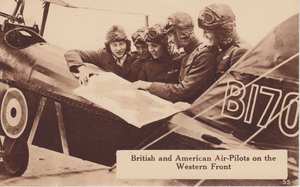From Parr’s Pilot’s Flying Log Book:
9:15 to 11:30 May 16 18 B170 17000 Off. Pat. Bethune Bailleul Vis Glentworth Leading. saw Hun 2 seater at 20000
4:45 to 7:30 16 M 18 B170 17000. O.P. Albert & Arras. Vis Glentworth Leading. Scrap with Huns at 8,000 over Remy
4:45 to 6:55 17 M 18 A.M. B170 17000 Albert & Arras, O.P. No Huns. Glentworth.
5:00 to 7:10 P.M. 17 My 18 B170 15000 O.P. Bray to Bapaume. 2 Form’t. of Huns No Fight. Did in U.C. Vee & Wing Spar Landing.
8:40 to 10.55 18 My 18 A.M. B170 165000 [sic] O.P. Douai to Villers. Capt. Vis. Leading dived on 2 Hun 2 seaters, Vis Glent’s Tail seemed to break over Etaing 11000 at 10:15
4:30 to 5:45 19 My 18 P.M. N.E. B170 Solo 4000 Beauvois Aerodrome Practice Stunts & Firing.
7:00 to 8:25 20 My 18 PM NE B170 Solo 7000 [Beauvois Aerodrome] Practice Formation Firing & Fighting.
6:10 to 8:30 21 My 18. AM. NE. B170 Solo 19500 Armentiers [sic] & Bethune Lt. Green Leading. Saw 5 Huns, no scrap.
5:35 to 8:05 21 My 18, PM NE B170 Solo 18500 Armentiers [sic] & LaBasse Bad Formation. Two leaders had engine trouble. I left Capt. Clayton [sic] when I thought he was of another squadron. After 2:15 hrs. 40 Huns jumped what was left of us I had just gone home.

Parr’s leader on the morning of May 16 was Edmond William Claude Gerard de Vere Pery, Viscount Glentworth, born in Ireland in 1894, the third child and only son of the 4th Earl of Limerick.427 A lieutenant in the Warwickshire Yeomanry, he was apparently traveling in the United States when World War I broke out. The marriage of his sister, Lady Victoria May [or Mary] Pery, to the wealthy New Yorker James Cox Brady, which was originally to have taken place at her home, Dromore Castle, in Ireland, was moved forward to October 14, 1914, and took place in New Jersey so that Glentworth could give her away before joining his regiment.428 At some point he transferred to the R.F.C.; by August of 1916 he had qualified as an observer and been appointed a 2nd lieutenant. He joined No. 32 Squadron in October 1917 when they were stationed in Droglandt and flying DH–5s. He returned to England in December and was briefly an instructor before returning to No. 32 Squadron in February of 1918; he was promoted to the rank of temporary captain in May.429
Parr’s entry for the morning offensive patrol on May 18 is not entirely clear: he writes “Tail seemed”; “Vis Glent’s” is written in above “seemed.” I have interpreted this as “Vis Glent’s tail seemed. . . .”
Three days later (May 21, 1918), Bogart Rogers, who had been rooming with Glentworth, wrote “concerning the strange story of the missing man.” Presumably because of the censor, Rogers does not identify the man, but it is evidently Glentworth. Rogers writes that inquiries made of troops on the ground after Glentworth failed to return from patrol indicated that he had regained control of his machine but landed over the lines and was a prisoner of war. However, even this was more optimistic than the truth, which was that Glentworth had perished.
After the war, on December 2, 1918, Rogers wrote “yesterday the C.O. and I went up to the awful area to look for the grave of Viscount Glentworth who was shot down just after I came to the squadron in May. We found it and what was left of the machine and put up a cross.” There are photos of the cross and the crash site on pages 223, 224, and 227 of Rogers’s letters. The caption for the last photo notes that “‘To a gallant British airman’ was written in German on a piece of a broken propeller.”
The leader of the morning offensive patrol on May 21 was Wilfrid Barratt Green. Six years younger than Parr, Green, like Vizard, had entered military service with the 28th London Regiment before joining the R.F.C., in which he attained the rank of Captain.430
Arthur Claydon, born in Lincolnshire, England, in 1885, emigrated to Canada in 1903 and was living in Winnipeg when he joined the Canadian Expeditionary Force in 1916. He initially served in the Canadian Field Artillery before transferring to the Royal Flying Corps. Serving with No. 32 Squadron, he was shot down on November 11, 1917, but went on to score his first victory on November 20, 1917. By the time Parr flew with him, he had been credited with two victories.431